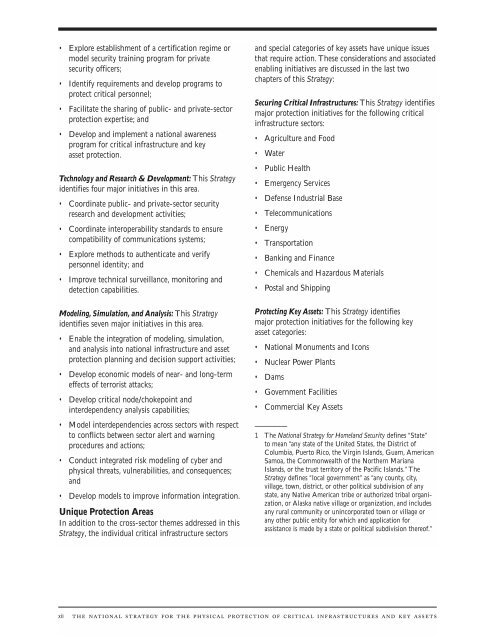the Physical Protection of Critical Infrastructures and Key Assets
the Physical Protection of Critical Infrastructures and Key Assets
the Physical Protection of Critical Infrastructures and Key Assets
You also want an ePaper? Increase the reach of your titles
YUMPU automatically turns print PDFs into web optimized ePapers that Google loves.
• Explore establishment <strong>of</strong> a certification regime or<br />
model security training program for private<br />
security <strong>of</strong>ficers;<br />
• Identify requirements <strong>and</strong> develop programs to<br />
protect critical personnel;<br />
• Facilitate <strong>the</strong> sharing <strong>of</strong> public- <strong>and</strong> private-sector<br />
protection expertise; <strong>and</strong><br />
• Develop <strong>and</strong> implement a national awareness<br />
program for critical infrastructure <strong>and</strong> key<br />
asset protection.<br />
Technology <strong>and</strong> Research & Development: This Strategy<br />
identifies four major initiatives in this area.<br />
• Coordinate public- <strong>and</strong> private-sector security<br />
research <strong>and</strong> development activities;<br />
• Coordinate interoperability st<strong>and</strong>ards to ensure<br />
compatibility <strong>of</strong> communications systems;<br />
• Explore methods to au<strong>the</strong>nticate <strong>and</strong> verify<br />
personnel identity; <strong>and</strong><br />
• Improve technical surveillance, monitoring <strong>and</strong><br />
detection capabilities.<br />
Modeling, Simulation, <strong>and</strong> Analysis: This Strategy<br />
identifies seven major initiatives in this area.<br />
• Enable <strong>the</strong> integration <strong>of</strong> modeling, simulation,<br />
<strong>and</strong> analysis into national infrastructure <strong>and</strong> asset<br />
protection planning <strong>and</strong> decision support activities;<br />
• Develop economic models <strong>of</strong> near- <strong>and</strong> long-term<br />
effects <strong>of</strong> terrorist attacks;<br />
• Develop critical node/chokepoint <strong>and</strong><br />
interdependency analysis capabilities;<br />
• Model interdependencies across sectors with respect<br />
to conflicts between sector alert <strong>and</strong> warning<br />
procedures <strong>and</strong> actions;<br />
• Conduct integrated risk modeling <strong>of</strong> cyber <strong>and</strong><br />
physical threats, vulnerabilities, <strong>and</strong> consequences;<br />
<strong>and</strong><br />
• Develop models to improve information integration.<br />
Unique <strong>Protection</strong> Areas<br />
In addition to <strong>the</strong> cross-sector <strong>the</strong>mes addressed in this<br />
Strategy, <strong>the</strong> individual critical infrastructure sectors<br />
<strong>and</strong> special categories <strong>of</strong> key assets have unique issues<br />
that require action. These considerations <strong>and</strong> associated<br />
enabling initiatives are discussed in <strong>the</strong> last two<br />
chapters <strong>of</strong> this Strategy:<br />
Securing <strong>Critical</strong> <strong>Infrastructures</strong>: This Strategy identifies<br />
major protection initiatives for <strong>the</strong> following critical<br />
infrastructure sectors:<br />
• Agriculture <strong>and</strong> Food<br />
• Water<br />
• Public Health<br />
• Emergency Services<br />
• Defense Industrial Base<br />
• Telecommunications<br />
• Energy<br />
• Transportation<br />
• Banking <strong>and</strong> Finance<br />
• Chemicals <strong>and</strong> Hazardous Materials<br />
• Postal <strong>and</strong> Shipping<br />
Protecting <strong>Key</strong> <strong>Assets</strong>: This Strategy identifies<br />
major protection initiatives for <strong>the</strong> following key<br />
asset categories:<br />
• National Monuments <strong>and</strong> Icons<br />
• Nuclear Power Plants<br />
• Dams<br />
• Government Facilities<br />
• Commercial <strong>Key</strong> <strong>Assets</strong><br />
________<br />
1 The National Strategy for Homel<strong>and</strong> Security defines “State”<br />
to mean “any state <strong>of</strong> <strong>the</strong> United States, <strong>the</strong> District <strong>of</strong><br />
Columbia, Puerto Rico, <strong>the</strong> Virgin Isl<strong>and</strong>s, Guam, American<br />
Samoa, <strong>the</strong> Commonwealth <strong>of</strong> <strong>the</strong> Nor<strong>the</strong>rn Mariana<br />
Isl<strong>and</strong>s, or <strong>the</strong> trust territory <strong>of</strong> <strong>the</strong> Pacific Isl<strong>and</strong>s.” The<br />
Strategy defines “local government” as “any county, city,<br />
village, town, district, or o<strong>the</strong>r political subdivision <strong>of</strong> any<br />
state, any Native American tribe or authorized tribal organization,<br />
or Alaska native village or organization, <strong>and</strong> includes<br />
any rural community or unincorporated town or village or<br />
any o<strong>the</strong>r public entity for which <strong>and</strong> application for<br />
assistance is made by a state or political subdivision <strong>the</strong>re<strong>of</strong>.”<br />
xii<br />
THE NATIONAL STRATEGY FOR THE PHYSICAL PROTECTION OF CRITICAL INFRASTRUCTURES AND KEY ASSETS

















